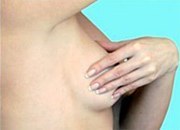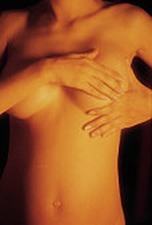Being Breast Aware
Being breast aware is an important step toward taking responsibility for your
own health.
Being breast aware means familiarising yourself with your breasts and the changes they go through during your life. You should know how your breasts look and feel normally so that you can notice any changes quickly.
 There is no set way to check your breasts, but you should find time to do it on a regular basis. The aim of breast awareness is to become familiar with the appearance,
There is no set way to check your breasts, but you should find time to do it on a regular basis. The aim of breast awareness is to become familiar with the appearance,
shape and feel of your breasts so that you will notice Any Change From The Normal You.
A change may be a lump or thickening of the breast tissue which you hadn’t
felt before or it may be a visual difference in the appearance of your breasts.
- What to look and feel for
- Change in the shape or size of the breasts
- Inflammation, redness or hot spots
- Ulcers or sores which don’t appear to be healing
- Change in the direction of the nipple
- Pulling in (retraction) of the nipple
- Discharge from the nipple (not breast milk)
- Any persistent rash on the breast
- Dimpling, puckering or flattening of the skin of the breast
- Any lump or thickening not felt before
- Swelling or shrinkage of part or all of the breast
- Lumps or thickening in the armpit
- Swelling or pain in the upper arm
- Orange peel texture to the skin of the breast
How
Remove your upper garment and stand in front of a good sized well lit
mirror.
- Keep your arms by your side and Look at your breasts
- Look at the shape and size of your breasts
- Look at the nipple area
- Look at the skin texture
 From time to time, use your hands to feel your breasts – perhaps in the shower or while dressing. Remember your breast tissue extends from your collarbone to your “bra-line” and around to your armpits.
From time to time, use your hands to feel your breasts – perhaps in the shower or while dressing. Remember your breast tissue extends from your collarbone to your “bra-line” and around to your armpits.
Your monthly period, pregnancy, age and weight changes may alter the shape, size and feel of your breasts. The aim is to become familiar with these changes so changes that are not normal for you can be detected.
Important
It is essential to see your doctor and have your breasts examined if you notice
any changes.
What to do
If you do notice a change in your breasts, try not to worry but see your GP as soon as you can.
Your GP may ask you to come back at a different time in your menstrual cycle, or send you to a breast clinic for a more detailed examination.
Please remember: most breast changes are not cancer, even if they need follow up treatment or further investigation.
- Know what is normal for you
- Know what changes to look and feel for
- Look and feel
- Report any changes to your GP without delay
- Attend for routine breast screening if you are aged 50 or over
Summary
Be Breast Aware
Whatever age you are, look at and feel your breasts regularly. You don’t have to use any special method. No one way is better than another, although some women prefer to use a systematic approach. If you notice any unusual changes see your doctor without delay. Being breast aware is important even if you are having regular mammograms.
Have Regular Screening Mammograms
If you are 50-69 years, it is recommended that you have a free screening mammogram every 2 years through BreastScreen Victoria. Women 40-49 years or 70 years and older are also eligible for free screening mammograms. Screening mammograms are not recommended for women younger than 40 years except in the uncommon situation of an exceptionally high risk family history.











